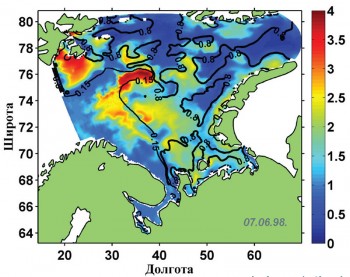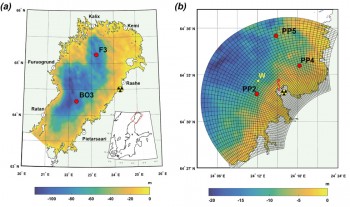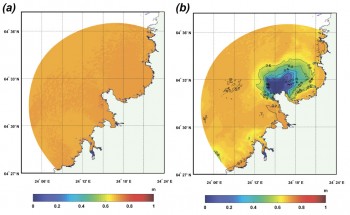Laboratory for modeling ocean biogeochemical cycles
Model estimates of the eutrophication of the Baltic Sea in the contemporary and future climate.
The St. Petersburg Baltic eutrophication model (SPBEM) is used to assess the ecological condition of the sea under possible changes in climate and nutrient loads in the 21st century. According to model estimates, in the future climate water quality will worsen, compared to modern conditions. This deterioration is stronger in the climate warming scenario with a stronger change in future near-surface air temperature. In the considered scenarios of climate change, climate warming will lead to an increase in the area of anoxic and hypoxic zones. Reduction of nutrient loading, estimated in accordance with the Baltic Sea Action Plan, will only be able to partially compensate for the negative effects of global warming.
Publications
1. Skogen M. D., K. Eilola, J. L. S. Hansen, H.E.M. Meier, M.S. Molchanov, V. A. Ryabchenko. 2014. Eutrophication Status of the North Sea, Skagerrak, Kattegat and the Baltic Sea in present and future climates: A model study. Journal of Marine Systems, 132, 174–184. dx.doi.org
2. Ryabchenko V.A., L.N. Karlin, A.V. Isaev, R.E. Vankevich, T.R. Eremina, M.S. Molchanov, O.P. Savchuk. 2016. Model estimates of the eutrophication of the Baltic Sea in the contemporary and future climate//Oceanology (English translation), Vol. 56, No. 1, pp. 36–45. DOI: 10.1134/S0001437016010161.
3. Vladimir Ryabchenko, Alexey Isaev. Eastern GOF under the climate change. In: The Gulf of Finland assessment. Mika Raateoja and Outi Set?l? (eds). Reports of the Finnish Environment Institute, 27. Finnish Environment Institute: 2016. P.132-133. helda.helsinki.fi
Model estimates of the impact of bioirrigation activity of Marenzelleria spp. on the Gulf of Finland ecosystem in a changing climate
Possible ecosystem mechanisms of drastic changes occurred in the Eastern Gulf of Finland due to invasion and establishment of polychaete Marenzelleria arctia are explored with the help of three-dimensional ecosystem model SPBEM. Relative significance of bioirrigation activity is studied by comparing results of two climate change scenario simulations, including or disregarding Marenzelleria effects. The novel results obtained with this approach demonstrate that on a system level biogeochemical consequences of both implemented climate changes scenario and polychaete activity are equivalent to a weakening of “vicious circle” of the Baltic Sea eutrophication. The eutrophication-mitigating effects of the Marenzelleria invasion into the Eastern Gulf of Finland, revealed by the long-term field measurements, are explained by simulation-based considerations.
Publications
Voloshchuk E.V., Eremina, T.R., Ryabchenko V.A. Modeling of biogeochemical processes in bottom sediments of the eastern part of the Gulf of Finland using the diagenetic model // Fundamentalnaya i prikladnaya gidrofizika. 2015. V. 8, No. 4. P.106-113( in Russian).
Eremina, T.R., Voloshchuk, E.V., and Maximov, A.A. 2016. Assessment of biogeochemical changes in the sediments of the Esatern part of the Gulf of Finland due to invasion of polychaete Marenzelleria spp. // Izvestija RGO, 148, №1: 55-71 (in Russian).
Isaev, A.V., Eremina, T.R., Ryabchenko, V.A., Savchuk, O.P., Model estimates of the impact of bioirrigation activity of Marenzelleria spp. on the Gulf of Finland ecosystem in a changing climate, J. Mar. Syst. (2016), dx.doi.org
Estimates of the effect of ice on the primary production of phytoplankton in the Barents Sea (based on three-dimensional modeling)

To get the estimates, we apply a three-dimensional eco-hydrodynamic model based on the Princeton Ocean Model which includes: 1) a module of sea ice with 7 categories, and 2) the 11-component module of marine pelagic ecosystem developed in the St. Petersburg Branch, Institute of Oceanology, RAS. Comparison of the model results for the period 1998-2007 with satellite data showed that the model reproduces the main features of the evolution of the sea surface temperature, seasonal changes in the ice extent, surface chlorophyll "a" concentration and the primary production of phytoplankton (PPP) in the Barents Sea. It is shown that the spring-summer bloom of phytoplankton in areas of the sea covered with ice occurs during the period of intensive destruction of the ice cover in its marginal zone. In particular, as can be seen in Fig. 1, on June 7, 1998, when a significant part of the sea was covered with ice, the areas of maximum concentrations of chlorophyll "a" were located in the marginal zone of the ice cover and in open water in the central part of the sea.
Model estimates of the annual PPP for whole sea, APPmod, appeared in 1.5-2.3 times more than similar estimates, APPdata, from satellite data. The main reasons for this discrepancy are: 1) APPdata refers to the open water, while APPmod, to the whole sea area (under the pack ice and marginal ice zone was produced 16 - 38% of PPF); and 2) values of APPdata are underestimated because of the subsurface chlorophyll maximum. During the period 1998-2007, the modelled maximal (in the seasonal cycle) sea ice area has decreased by 15%. This reduction was accompanied by an increase in annual PPF of the sea at 54 and 63%, based, respectively, on satellite data and the model for the open water. According to model calculations for the whole sea area, the increase is only 19%. We conclude that an adequate assessment of primary production in ice-covered seas can only be obtained on the basis of eco-hydrodynamic models, including sea ice.
Publications
Ryabchenko V.A., Gorchakov V.A., Dvornikov A.Yu., Pugalova S.S. Estimating the effect of ice on the primary production of phytoplankton in the Barents Sea (based on three-dimensional modeling). Fundamentalnaya i prikladnaya gidrofizika. 2016, 9, 1, 41—51.


Assessment of extreme hydrological conditions in the Bothnian Bay, Baltic Sea, and the impact of the nuclear power plant “Hanhikivi-1” on the local thermal regime
The results of the study aimed to assess the influence of future nuclear power plant (NPP) "Hanhikivi-1"(Fig.2) upon the local hydrological conditions in the Bothnian Bay in the Baltic Sea are presented. A number of experiments with different numerical models were also carried out in order to estimate the extreme hydro-meteorological conditions in the area of the construction.
The numerical experiments were fulfilled both with analytically-specified external forcing and with real external forcing for two years: a cold year (2010) and a warm year (2014).
It is established that from the point of view of generation of wind waves in the NPP area, the northwest wind with a direction of 310° is most dangerous. The maximum values of significant wave heights for this wind and speed 10m s-1 near the NPP are 1.2-1.4 m.
It is estimated that the maximum and minimum sea level values near nuclear power plants can reach 248 cm and -151 cm, respectively, in the case of west and east winds. Permanent release of heat into the marine environment from operating nuclear power plant will lead to a strong increase in temperature and the disappearance of ice cover around 2 km vicinity of the station(Fig.3).
These effects should be taken into account when assessing local climate changes in the future.
Publications
Vladimir Ryabchenko, Anton Dvornikov, Tatjana Eremina, Alexey Isaev and Stanislav Martyanov. Possible consequences of the construction of the NPP "Hanhikivi-1" for the marine environment of the Gulf of Bothnia: model estimates. Proc. the 1st Baltic Earth Conference, Nida, Curonian Spit, Lithuania 13 - 17 June 2016. International Baltic Earth Secretariat Publication No. 9, June 2016, pp. 94-95. BalticEarth_Nida2016_Proceedings_web.pdf
Dvornikov, A.Y., Martyanov, S.D., Ryabchenko, V.A., Eremina, T.R., Isaev, A.V., and Sein, D.V.: Assessment of extreme hydrological conditions in the Bothnian Bay, Baltic Sea, and the impact of the nuclear power plant “Hanhikivi-1” on the local thermal regime, Earth Syst. Dynam., 8, 265-282, doi:10.5194/esd-8-265-2017, 2017.